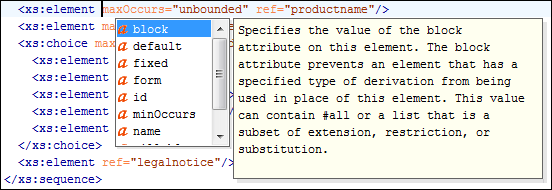Content Completion Assistant in Text Mode
Oxygen XML Editor includes an intelligent Content Completion Assistant that offers proposals for inserting structured language elements, attributes, and attribute values that are valid in the current editing context.
The Content Completion Assistant is enabled by default. To disable it, open the Preferences dialog box , go to , and deselect the Enable content completion option.

Content Completion and the Associated Schema
The Content Completion Assistant feature is schema-driven and the list of proposals in the Content Completion Assistant depend on the associated schemas (DTD, XML Schema, Relax NG, or NVDL schema). For information about the various ways to associate a schema and the order of their precedence, see the Associating a Schema to XML Documents section.
Using the Content Completion Assistant in Text Mode
- After you enter the < character when inserting an element, it is automatically activated after a short delay. You can adjust the activation delay with the Activation delay of the proposals window (ms) option from the Content Completion preferences page.
- After typing a partial element or attribute name, you can manually activate it by pressing Ctrl + Space or Alt + ForwardSlash (Command + Option + ForwardSlash on macOS). If there is only one valid proposal at the current location, it is inserted without displaying the list of proposals.
You can navigate through the list of proposals by using the Up and Down keys on your keyboard. In some cases, the Content Completion Assistant displays a documentation window with information about the particular proposal and some of them have links to additional information (for example, DITA elements might have a link to the DITA Style Guide). You can also change the size of the documentation window by dragging its top, right, and bottom borders.
- Press Enter or Tab to insert both the start and end tags and position the cursor inside the start tag in a position suitable for inserting attributes.
- Press Ctrl + Enter (Command + Enter on macOS) to insert both the start and end tags and positions the cursor between the tags in a position where you can start typing content.
After inserting an element, the cursor is positioned:
- Before the > character of the start tag, if the element allows attributes, to allow rapid insertion of any of the attributes supported by the element. Pressing the space bar displays the Content Completion list once again. This time it contains the list of allowed attribute names. If the attribute supports a fixed set of parameters, the assistant list displays the list of valid parameters. If the parameter setting is user-defined and therefore variable, the assistant is closed to allow manual insertion. The values of the attributes can be learned from the same elements in the current document.
- After the > character of the start tag, if the element has no attributes.
Where the Content Completion Assistant is Displayed
The Content Completion Assistant is displayed:
- Anywhere within a tag name or at the beginning of a tag name in an XML document, XML Schema, DTD, or Relax NG (full or compact syntax) schema.
- Anywhere within an attribute name or at the beginning of an attribute name in any XML document with an associated schema.
- Within attribute values or at the beginning of attribute values in XML documents where lists of possible values have been defined for that element in the schema associated with the document.
Types of Proposals Listed in the Content Completion Assistant
- Element Structure Specified in DTD or Schema
- The proposals that populate the Content Completion Assistant depend on
the element structure specified in the DTD, XML Schema, Relax NG (full or compact
syntax) schema, or NVDL schema associated with the edited document.Note: The Content Completion Assistant is able to offer elements defined both by XML Schemas version 1.0 and 1.1.
- Current Cursor Position
- The number and type of elements displayed by the Content Completion Assistant is dependent on the cursor's current position in the structured document. The child elements displayed within a given element are defined by the structure of the specified DTD, XML Schema, Relax NG (full or compact syntax) schema, or NVDL schema.
- Unique ID Attribute Values
- A schema may declare certain attributes as ID or
IDREF/IDREFS. When the document is validated, Oxygen XML Editor checks the uniqueness and correctness of the
@idattributes. It also collects the attribute values declared in the document to prepare the list of proposals. This is available for documents that use DTD, XML Schema, and Relax NG schema. - Values for xml:id Attributes
- Values of all the
@xml:idattributes are handled as@idattributes. They are collected and displayed by the Content Completion Assistant as possible values for anyURI attributes defined in the schema of the edited document. This works only for XML Schema and Relax NG schemas. - Links/References in DITA
- When entering values for the various types of links and references in DITA (for
example, values for
@hrefor@conrefelements), the Content Completion Assistant will propose potential targets when you use the forward slash key (/). - ID Values for DITA Key References
- In DITA, when inserting key references (
@keyref) or content key references (@conkeyref), the ID values that are defined in the key reference are presented as possible targets. The Content Completion Assistant will only propose targets that are valid in the current context. - Element and Attribute Values
- For documents that use an XML Schema or Relax NG schema, the Content Completion Assistant offers proposals for attribute and element values as long as the allowed values are defined in the schema. Also, if a default value or fixed value is defined in the schema, then that value is offered in the Content Completion Assistant.
